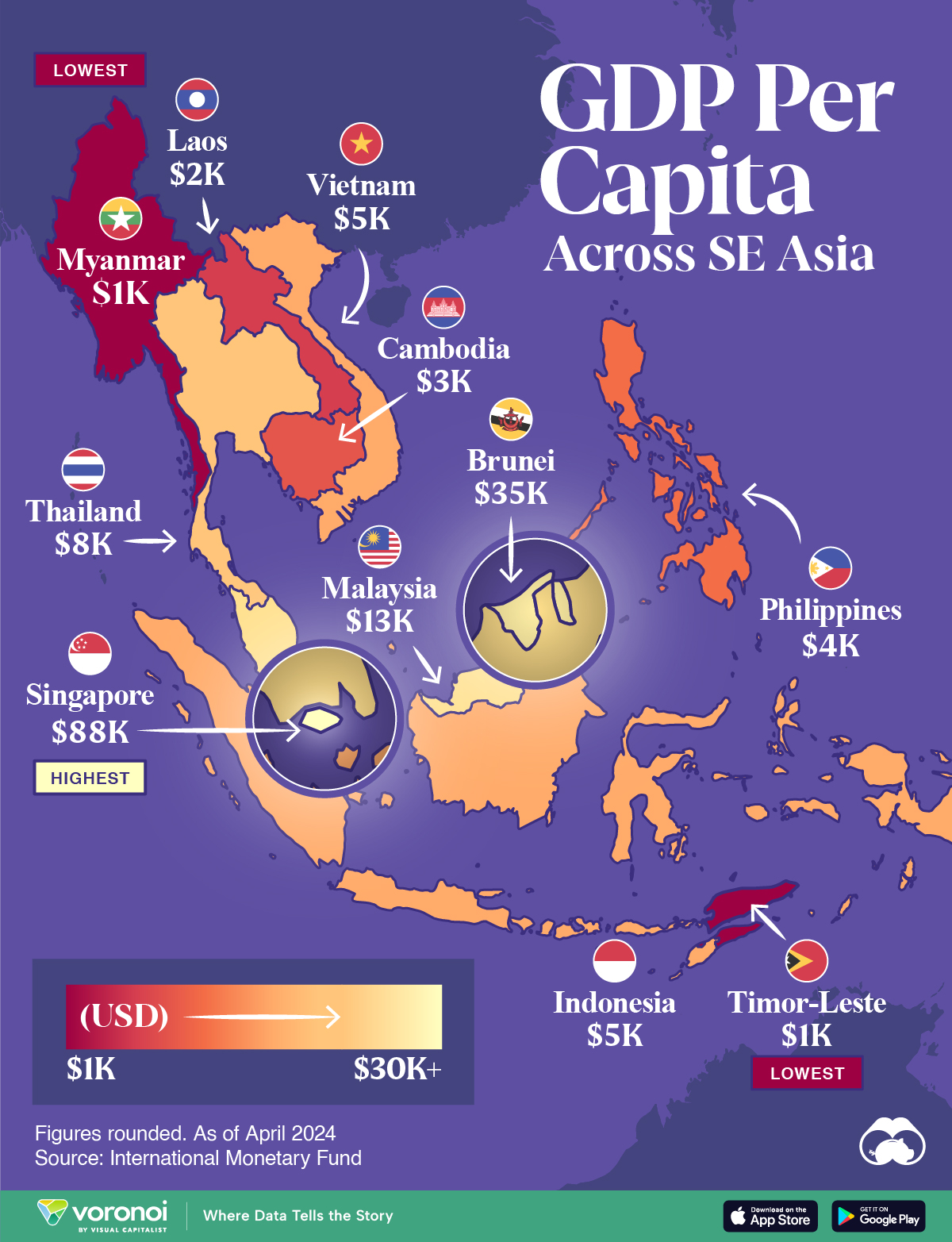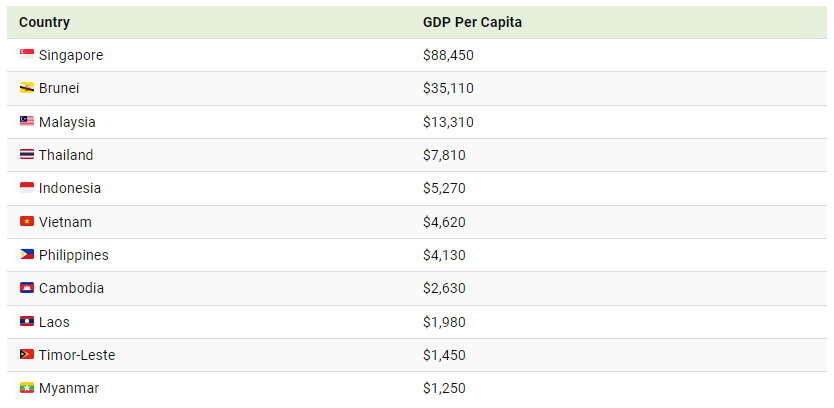The regional leader will not surprise anyone, but how do the other nations of Southeast Asia rank?
To eliminate any inkling of suspense and confirm what you already know, yes, it’s Singapore at the top of the ASEAN list yet again, this time for gross domestic product (GDP) per capita.
What might shock you, however, is by just how much Singapore leads the pack. It’s not even close.
According to reporting by Visual Capitalist, when it comes to ASEAN, Singapore stands head-and-shoulders above its neighbours with a GDP per capita exceeding $88,000, making it one of the wealthiest nations globally by this metric.
In fact, Singapore’s GDP per capita is so high, if you add up all the other ASEAN countries’ totals – and even count Malaysia’s figure twice! – Singapore’s number is still higher. Let that one sink in for a moment.

Despite its modest size of 734 sq km, a population of only 5.6 million, and virtually no natural resources, Singapore thrives economically and delivers not only considerable wealth to its residents, but a high standard of living. The key to its prosperity lies in its strategic location, which has established it as a vital hub for trade and commerce in the region. This advantageous positioning continues to drive its economic success and global influence.
Singapore has also benefitted over the decades from forward-thinking leadership and a population that, to some extent, accepted – through an unspoken social contract – a reduction of personal liberties (with many choices ceded to the government) in exchange for prosperity, safety, and modernisation unrivalled in the region.
As a result of these dynamics, Singapore has far exceeded its neighbours, and indeed much of Asia, at least in respect to its wealth.

WHAT IS GDP?
In 1937, amid America’s struggles with the Great Depression, Russian-born economist Simon Kuznets introduced a groundbreaking concept for gauging a nation’s economy: gross domestic product, or GDP. This innovative metric transformed economic analysis by offering a comprehensive measure of a nation’s economic activity and output.
Essentially, GDP is a measure of the total value of all goods and services produced within a country over a specific period, usually a year. In simpler terms, it’s like adding up all the money spent on things like groceries, cars, and services like healthcare and education, plus investments and government spending. GDP is used to gauge the economic health of a country and to compare the economic performance of different countries.
Nearly eight decades on, GDP, along with GDP per capita – which facilitates population-based comparisons – remains a critical statistic for evaluating and comparing the economic performance and productivity of countries worldwide. This enduring benchmark continues to shape how we understand and assess global economies.
SOUTHEAST ASIA’S ECONOMIES
Though Singapore has, by far, the highest GDP per capita, theirs is not Southeast Asia’s largest economy. That distinction belongs to Indonesia, the world’s fourth-most populous country.
Thailand is ranked second by overall GDP, and then Singapore, despite its relatively tiny population, comes in third place. The Philippines, another very populous country, is ranked as ASEAN’s fourth-largest economy. Vietnam is in fifth place, followed by Malaysia in sixth place. Then, in order, Myanmar, Cambodia, Brunei, and Laos round out the countries of Southeast Asia.
Though GDP gives an accurate glimpse of the size of a country’s overall economy, GDP per capita is a more useful metric for general understanding of the income (and typically, the living standards) of an average person in that country. In the rankings above, Indonesia has a massive economy, but that’s because they have a huge population – some 279 million. So when you factor that in, the per capita GDP is quite low. But even when taken together, these metrics can obscure sizeable gaps between the very rich and the very poor within a given country. Again, Indonesia provides a good example of this dynamic.
There are also surprising relationships that seem paradoxical. For instance, Brunei’s citizens are, on the whole, quite wealthy, as evidenced by their lofty ranking in ASEAN GDP per capita. But since the population is so very small, their overall economy is near the bottom of the list for Southeast Asia.
The nearby island country of the Maldives has an economy generally regarded as small and relatively poor. However, a large tax base fed by tourism receipts combined with a small population means that their per capita GDP is a surprisingly robust $19,558, notably higher than Malaysia’s $13,310.
Malaysia has set out to become a “high-income nation” by 2030. However, this metric is typically informed by a different statistic, Gross National Income per capita. The World Bank in 2022 considered countries with a per capita GNI per capita of US$13,845 or more to be high-income nations.
In 2022, Malaysia’s GNI per capita was US$11,830.
"ExpatGo welcomes and encourages comments, input, and divergent opinions. However, we kindly request that you use suitable language in your comments, and refrain from any sort of personal attack, hate speech, or disparaging rhetoric. Comments not in line with this are subject to removal from the site. "





















